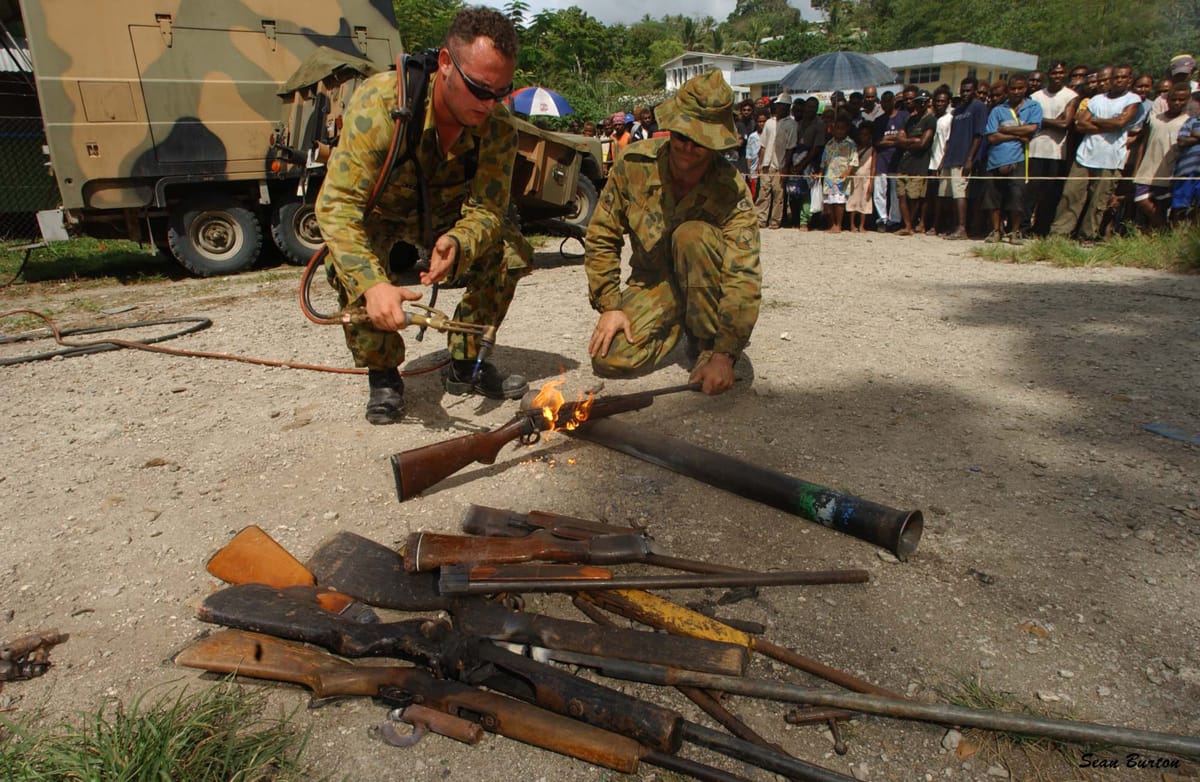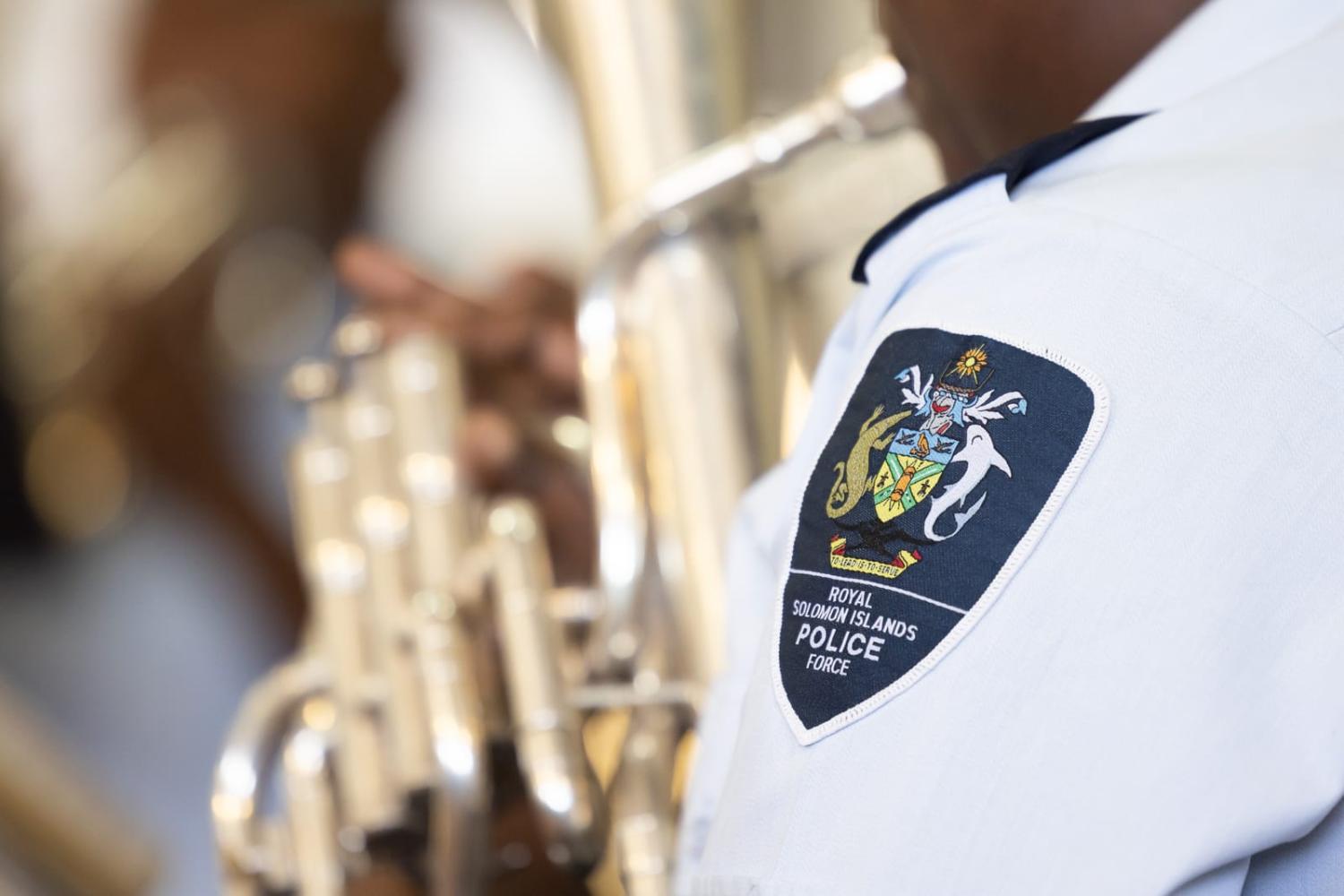When Solomon Islands Prime Minister Sogavare declared last week he wanted to establish a national military force to fill security gaps in the country, it sparked concern among civil society, media and international observers alike.
One of the successes of the 14-year Regional Assistance Mission to Solomon Islands (RAMSI) was disarmament, removing about 4000 weapons in its first year, 2003. Many of those guns had been stolen from police armaments and a concerted effort involving most Pacific Island nations disarmed local militants and brought stability. Even so, the fear of gun violence and intimidation from those times remains.
When rioting broke out again in November 2021, the Solomon Islands government requested help from Australia, Fiji, New Zealand and Papua New Guinea, and that international assistance force remains in Honiara. Yet Honiara also later signed policing and broader security agreements with China, which includes overlapping functions with a 2017 security treaty with Australia, as well as Pacific Islands regional security agreements. Issues of interoperability have not been resolved.
Now comes Sogavare’s move to establish a defence force, which raises three broad questions. Why now? Would it be effective? How will those in the region respond?
Sogavare visited Beijing in July to seal security and trade related agreements, commenting that Solomon Islands had an “inadequately resourced police force”. Rather than laying out a plan to boost police and community capability, he argued it was time to “break the dependence it has on external security arrangements” and create its own armed forces. The timing raises the prospect that this was discussed with Beijing.
Yet it is not clear that a military capability will fix the security challenges facing the nation. The Solomon Islands 2020 National Security Strategy identifies 17 security threats from climate change to health security. Notably, it states that the threat of ethnic conflict and political and social instability are best met with economic development and a whole-of-government development approach. The strategy cites external threats including transnational crime and foreign interference, which again are challenges not best countered by a military.
Currently, there is no external military threat, nor is one likely. The last time Solomon Islands faced an incursion into its territory was during the Bougainville conflict, prior to that the Second World War.

Standing up a capable and effective armed force is costly for a country with limited resources. The current police force of about 1500 officers is under-resourced and too few for a population of more than 700,000. An additional security force with the creation of a military would compete for resources, struggle to perform better, and risk being captured by ethnic or vested interests. Already the parliamentary opposition, and former Malaitan premier and his supporters, have raised concerns about military support from the West via visiting defence forces and the lack of dialogue with local leaders and people.
Importantly, it is not clear if the Solomon Islands government has the social license to establish a military force. Gauging public support is difficult because there is little public debate. Since the tensions in the late 1990s and early 2000s leading to the RAMSI deployment, there appears to be little public appetite for arms or a military. Only a few special groups in the police carry arms, and even this faced opposition. While police capability has improved, public trust remains low. Better resourcing of the police and culturally appropriate policing is needed more than a military.
The World Bank has identified Solomon Islands as having a low level of institutional and governance capacity, which significantly impinges the state’s ability to function effectively. The most pressing security concerns that the government confronts revolve around climate change, environmental degradation and inequitable development. Such threats are better addressed by targeted government spending and development assistance, with security efforts working in tandem. This would be consistent with Pacific leaders’ push for a more integrated and regional approach that addresses climate, human and traditional security systemically.
This is not to deny that security gaps exist and need attention. There has been repeated civil unrest, mining and logging related conflicts, corruption, crime, family and gender violence, as well as tensions between the national and provincial governments. Border security, cybersecurity, and transnational crime are increasing. The surrounding oceans are not well covered by surveillance. Other domestic challenges loom – including providing security for the Pacific Games later this year, and elections early next year. But a military is unlikely to be the answer.
Geopolitical rivalries are being leveraged, however, to advance Sogavare’s desire to have a military. Australia’s Defence Minister Richard Marles declared he was “very keen” to support Sogavare’s initiative. This interest is easy to understand. A Solomon Islands defence force could create another way for Australia and the United States to engage, and contribute to human and environmental crisis response, as well as to civil infrastructure building and maintenance. It would be another channel for partnership and assistance.
But this would not be without risk. China could also be engaged to help stand up the military. This would see a replay of the present policing concerns held by Western development partners on a larger scale. And all this investment in security may not reduce the drivers of insecurity, which remain mainly social and economic.
The numerous calls not to militarise the region seem at odds with investing in a defence force. These are sovereign decisions, and there may come a time for the country to establish a defence force, but the current opportunity costs and conflict risks are high. Rather than leaping to create a whole new force, it may be best for all to work with Solomon Islands on the most pressing security challenges and build the capacity of existing local and regional institutions – one step at a time.


